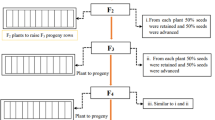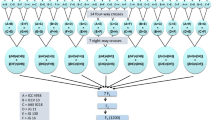Abstract
Grain yield and seed size are key breeding objectives for the chickpea breeding program in Morocco. Six winter-type chickpea (Cicer arietinum L.) varieties released between 1992 and 2015, and two candidate lines, were evaluated under different environments in order to study the stubility of grain yield and seed size across locations and to assess the genetic gain.. The varieties and candidates lines were evaluated in field experiments using a randomized complete block design with four replications in 9 different environments. The results showed that in 27 years of breeding, the average value of hundred seed weight improved from 33 to 47 g. Greater genetic progress was made for seed size than for grain yield. Average yearly genetic gains of 1.30 were recorded for seed size. Most varieties had wide adaptation and responded positively to the increase in environmental index. However, differences between varieties in terms of adaptation and stability were observed. A clear increase in seed size, an important market trait for chickpea in Morocco, is observed in the more recent improved genotypes. The improvement in seed size had limited penalty on yield as shown by a joint stable to slightly increasing or decreasing in grain yield thought years of breeding. These results could help draw more attention to the importance of winter-sown chickpea and enhance its adoption in Morocco. The end results could be the enhancement of national food production and security.







Similar content being viewed by others
References
Annicchiarico, P (2002) Genotype ´ environment interactions: Challenges and opportunities for plant breeding and cultivar recommendations. FAO Production Prot. Paper 174. FAO, Rome.
Barili LD, Vale NM, do, Carneiro JE de S, et al (2016) Five decades of black common bean genetic breeding in Brazil. Pesqui Agropecu Trop 46:259–266. https://doi.org/10.1590/1983-40632016v4641371
Cox TS, Shroyer JP, Ben-Hui L et al (1988) Genetic improvement in agronomic traits of hard red winter wheat cultivars 1919 to 1987. Crop Sci. https://doi.org/10.2135/cropsci1988.0011183X002800050006x
de Mendiburu, F (2017) agricolae: Statistical procedures for agricultural research. R package version 1.2-8. R Found. Stat. Comput. https://CRAN.R-project.org/package=agricolae. Accessed 17 July 2020.
De Vita P, Nicosia OLD, Nigro F et al (2007) Breeding progress in morpho-physiological, agronomical and qualitative traits of durum wheat cultivars released in Italy during the 20th century. Eur J Agron 26:39–53. https://doi.org/10.1016/j.eja.2006.08.009
FAOSTAT (2017) FAOSTAT. FAO, Rome. http://faostat.fao.org/. Accessed 02 June 2019.
Fischer G, Tubiello FN, van Velthuizen H, Wiberg DA (2007) Climate change impacts on irrigation water requirements: effects of mitigation, 1990–2080. Technol Forecast Soc Chang 74:1083–1107. https://doi.org/10.1016/j.techfore.2006.05.021
Gauch HG (1988) Model selection and validation for yield trials with interaction. Biometrics 44:705–715. https://doi.org/10.2307/2531585
Gauch HG (1992) Statistical analysis of regional yield trials: AMMI analysis of factorial designs. Elsevier, Amsterdam
Gauch H, Zobel W (1996) AMMI analysis of yield trials. In: Gauch HG, Kang M (eds) Genotype-by-environment interaction. CRC Press, Florida, pp 85–122
Gauch HG, Piepho H-P, Annicchiarico P (2008) Statistical analysis of yield trials by AMMI and GGE: further considerations. Crop Sci. https://doi.org/10.2135/cropsci2007.09.0513
Hawtin, G. C. and Singh K. B. (1984) Prospects and potential of winter sowing of chickpea in the Mediterranean Region. Ascochyta blight and winter sowing of chickpeas. M. C. Saxena and K. B. Singh, Netherlands. pp 7–16
Hossain, S.; Ford, R.; McNeil, D.; Pittock, C.; Panozzo, J.F (2010) Inheritance of Seed Size in Chickpea (Cicer arietinum L.) and Identification of QTL Based on 100-seed Weight and Seed Size Index. Aust. J. Crop Sci. 4: 126–135.
Houasli C, Idrissi O, Nsarellah N (2020) Chickpea genetic improvement in Morocco: state of the art, progress and prospects. Mor J Agri Sci 1:5–8
Idrissi O, Sahri A, Houasli C, Nsarellah N (2019) Breeding progress, adaptation, and stability for grain yield in moroccan lentil improved varieties. Crop Sci 59:925. https://doi.org/10.2135/cropsci2018.07.0431
Kamal M (1988) Potential for winter chickpea in Morocco. In: Summerfield RJ (ed) World crops: cool season food legumes: a global perspective of the problems and prospects for crop improvement in pea, lentil, faba bean and chickpea. Springer, Netherlands, Dordrecht, pp 175–180
Keneni G, Bekele E, Imtiaz M et al (2011) Breeding chickpea (Cicer arietinum [Fabaceae]) for better seed quality inadvertently increased susceptibility to adzuki bean beetle (Callosobruchus chinensis [Coleoptera: Bruchidae]). Int J Trop Insect Sci 31:249–261. https://doi.org/10.1017/S1742758411000373
Kivrak KG, Eker T, Sari H et al (2020) Integration of extra-large-seeded and double-podded traits in chickpea (Cicer arietinum L.). Agronomy 10:901. https://doi.org/10.3390/agronomy10060901
Kostrinski, J. 1974. Chickpea population and seed yield. p. 54. In Spec. Publ. No. 34. Agric. Res. Org., Volcani Centre, Israel.
Laidig F, Piepho H-P, Rentel D et al (2017a) Breeding progress, environmental variation and correlation of winter wheat yield and quality traits in German official variety trials and on-farm during 1983–2014. Theor Appl Genet 130:223–245. https://doi.org/10.1007/s00122-016-2810-3
Laidig F, Piepho H-P, Rentel D et al (2017b) Breeding progress, genotypic and environmental variation and correlation of quality traits in malting barley in German official variety trials between 1983 and 2015. Theor Appl Genet 130:2411–2429. https://doi.org/10.1007/s00122-017-2967-4
Malosetti M, Ribaut J-M, van Eeuwijk FA (2013) The statistical analysis of multi-environment data: modeling genotype-by-environment interaction and its genetic basis. Front Physiol. https://doi.org/10.3389/fphys.2013.00044
Peltonen-Sainio P, Peltonen J (1994) Progress since the 1930s in breeding for yield, its components, and quality traits of spring wheat in Finland. Plant Breeding 113:177–186. https://doi.org/10.1111/j.1439-0523.1994.tb00721.x
Purchase, J.L. (1997). Parametric analysis to describe genotype x environment interaction and yield stability in winter wheat.PhD. Thesis. University of the Orange Free State.
Quiroga S, Iglesias A (2009) A comparison of the climate risks of cereal, citrus, grapevine and olive production in Spain. Agric Syst 101:91–100. https://doi.org/10.1016/j.agsy.2009.03.006
R Core Team. (2018) R: A language and environment for statistical computing. R Found. Stat. Comput., Vienna
Rawal, V.; Navarro, D.K (2019) The Global Economy of Pulses; FAO: Rome, Italy. p. 190.
Saadi S, Todorovic M, Tanasijevic L et al (2015) Climate change and Mediterranean agriculture: Impacts on winter wheat and tomato crop evapotranspiration, irrigation requirements and yield. Agric Water Manag 147:103–115. https://doi.org/10.1016/j.agwat.2014.05.008
Sundaram P, Samineni S, Sajja SB et al (2019) Inheritance and relationships of flowering time and seed size in kabuli chickpea. Euphytica 215:144. https://doi.org/10.1007/s10681-019-2464-8
Tadesse M, Funga A, Fikre A et al (2018) Breeding progress for grain yield and yield related characters of kabuli chickpea (Cicer arietinum L.) in Ethiopia using regression analysis. JAS. https://doi.org/10.5539/jas.v10n2p195
Taghouti, M., N. Nsarellah, F. Gaboun, and A. Rochdi (2017) Multi-environment assessment of the impact of genetic improvement on agronomic performance and on grain quality traits in Moroccan durum wheat varieties of 1949 to 2017. Glob. J. Plant Breed. Genet. 4:394–404.
Tefera H, Kamara AY, Asafo-Adjei B, Dashiell KE (2010) Breeding progress for grain yield and associated traits in medium and late maturing promiscuous soybeans in Nigeria. Euphytica 175:251–260. https://doi.org/10.1007/s10681-010-0181-4
Tolessa, T., Keneni, G., & Mohammad, H. (2015) Genetic progresses from over three decades of faba bean (Vicia faba L.) breeding in Ethiopia. Australia Journal of Crop Science, 9, 4–48
Tutwiler,R.N (1995) The great chickpea challenge: introducing winter sowing in the Mediterranean region. ICARDA-Social-Science-Papers 4, p.30.
Upadhyaya HD, Sharma S, Gowda CLL (2011) Major genes with additive effects for seed size in kabuli chickpea (Cicer arietinum L.). J Genet 90:479–482. https://doi.org/10.1007/s12041-011-0099-1
Wallace T, Murray R, Zelman K (2016) The nutritional value and health benefits of chickpeas and hummus. Nutrients 8:766. https://doi.org/10.3390/nu8120766
Yigezu YA, El-Shater T, Boughlala M et al (2019) Legume-based rotations have clear economic advantages over cereal monocropping in dry areas. Agron Sustain Dev 39:58. https://doi.org/10.1007/s13593-019-0602-2
Acknowledgements
The authors would like to thank INRA staff members of experimental stations for their contribution to laboratory and fieldwork.
Funding
This research was funded by the INRA research budget.
Author information
Authors and Affiliations
Contributions
CH and OI designed the study. CH managed and supervised the experiments. and recorded data. ChH, OI, AS and NN analyzed data. interpreted results. and contributed to writing the paper.
Corresponding author
Ethics declarations
Conflicts of interest
The authors declare no conflict of interest.
Additional information
Publisher's Note
Springer Nature remains neutral with regard to jurisdictional claims in published maps and institutional affiliations.
Rights and permissions
About this article
Cite this article
Houasli, C., Sahri, A., Nsarellah, N. et al. Chickpea (Cicer arietinum L.) breeding in Morocco: genetic gain and stability of grain yield and seed size under winter planting conditions. Euphytica 217, 159 (2021). https://doi.org/10.1007/s10681-021-02885-x
Received:
Accepted:
Published:
DOI: https://doi.org/10.1007/s10681-021-02885-x




